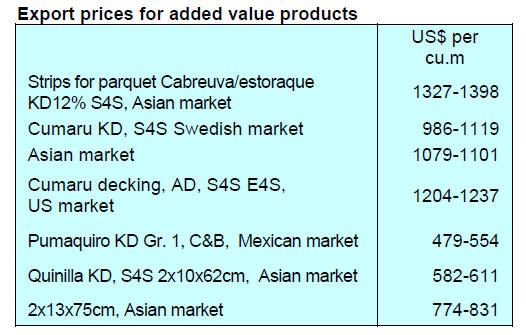4.
INDONESIA
Benchmark price information system
The Ministry of Environment and Forestry (Directorate of IPHH) is
developing a Benchmark Price Information System (SIPATOK) for forest
products to generate fair Non-Tax State Revenue (PNBP) for the State.
The SIPATOK is being tested in four provinces: Riau, as a representative for
Sumatra, East Java (Java region), East Kalimantan (Kalimantan region) and
South Sulawesi (East Indonesia region). One of the reasons for the
development of SIPATOK is to optimise Non-Tax Revenue.
Based on data from the Directorate General of Sustainable Forest Management
of the Ministry of Environment and Forestry (KLHK) over the last five years
(2018-2022), Non-Tax Revenue from forest utilisation was IDR2.8 - 3.2
trillion per year. This is very small when compared to the potential
considering that production forests in Indonesia cover an area of 68.83
million hectares.
A Ministerial Regulation regarding Benchmark Prices will serve as a guide in
submitting data and information on forest product prices to ensure the
fulfillment of fairness in setting prices reflecting the market prices for
forest products.
SIPATOK will simplify the process of collecting
data and information on prices of forest products and setting benchmark
prices as well as providing access to business actors to directly convey the
real selling prices of forest products based on sales documents/invoices and
other sales documents.
https://agroindonesia.co.id/klhk-kembangkan-sistem-informasi-harga-patokan-sipatok-hasil-hutan-untuk-pnbp-yang-berkeadilan/
Minister unwaveringly in rejection of trade discrimination
Indonesian Coordinating Minister for Economic Affairs, Airlangga
Hartarto, recently met with President Joko Widodo to report the results of
the Indo-Pacific Economic Framework (IPEF) meeting. Airlangga highlighted
several regulations in other countries that are deemed detrimental to
Indonesia.
Airlangga reported on trade facilitation which is still under discussion at
IPEF which has not been completed, the supply chain discussion was completed
as was discussion on the green economy fair economy. Airlangga also informed
the President on the European Union Deforestation Regulation (EUDR). He said
“within 18 months forest commodities must be verified through due diligence
statements and tagging.
Airlangga argued that the EUDR regulation is detrimental to Indonesia
because the implementation does not provide time to adjust saying, “if
within 18 months Indonesia does not comply with the EUDR then a large part
of trade relations with Europe will be disrupted”.
Minister Hartarto appears unwaveringly in his rejection of discrimination by
trading partner countries through the EUDR and Carbon Border Adjustment
Mechanism (CBAM).
CBAM is a policy tool introduced by the EU that requires EU iron and steel
importers to be subject to additional obligations to pay carbon tax rates in
accordance with the amount of iron and steel imported.
The Minister seems to consider the EUDR policy will hurt and harm several
plantation and forestry commodities in Indonesia and Malaysia. In addition,
the EUDR undermines Indonesia's commitments to solve problems related to
climate change issues and to protect biodiversity.
See:
https://en.antaranews.com/news/284244/minister-hartarto-firmly-rejects-discrimination-in-eudr-cbam-policies
and
https://investor.id/business/331568/ri-tolak-kebijakan-diskriminasi-deforestasi-oleh-uni-eropa
Plans to have the forestry sector offset carbon emissions
The Environment and Forestry Ministry plans to have the forestry
sector offset carbon emissions produced by the energy sector with the target
of reaching a net reduction of 140 million tonnes of carbon dioxide
equivalent by 2030.
The ministry's Climate Change Control Director General, Laksmi Dhewanthi,
stated that the energy sector's emissions are still projected to increase in
order to meet the domestic energy demand. "Indonesia, in terms of energy
consumption per capita, is still far below that of average middle-income
countries," she noted in a statement on Tuesday.
If the energy sector still contributes to emissions in the future, then the
forestry sector can already reduce emissions first to achieve a balance
between various sectors in Indonesia, Dhewanthi noted.
See:
https://en.antaranews.com/news/284136/ministry-plans-to-have-forestry-sector-offset-carbon-emissions
Stimulating forestry sector green investment
Agus Justianto, Director General of Sustainable Forest Management,
Ministry of Environment and Forestry said the Ministry (KLHK) supports
growth in green investment in the forestry sector which promises profits for
investors as well as positive impacts on environmental and social
management. He said "green investment is not only oriented to get financial
returns but also produces social and environmental impacts in a sustainable
manner".
One of the efforts to stimulate growth of green investment in the forestry
sector is optimising the economic value of carbon (Carbon Pricing). Carbon
pricing arrangements in the work area of Forest Utilisation Permits (PBPH)
are guided by Presidential Regulation Number 98 of 2021 and Minister of
Environment and Forestry Regulation Number 21 of 2022.
See:
https://forestinsights.id/2023/06/02/klhk-rangsang-investasi-hijau-sektor-kehutanan/
Indonesia braces for forest fires amid El Nino
Indonesia is bracing for the possibility of widespread forest and
land fires this year as scientists predict the return of the El Nino weather
phenomenon in the second half of 2023.
Indonesian National Disaster Mitigation Agency (BNPB) spokesman, Abdul
Muhari, said cases of forest and land fires dropped significantly over the
past three years because of the La Nina weather phenomenon which resulted in
more rainfall.
The World Meteorological Organisation (WMO) said there are signs that the
warm weather phenomenon El Nino will be back this year.
See:https://www.channelnewsasia.com/asia/indonesia-forest-fires-dry-weather-el-nino-3545281
Social forestry permits benefit 1.2 million
families
Since it was implemented in 2016 the area of Social Forestry
Permits as of May 2023 reached 5.5 million hectares comprising over 8,000
units for approximately 1.2 millinon heads of families.
The Minister of Environment and Forestry, Siti Nurbaya, emphasised that the
Social Forestry Programme is one of the national strategic programmes.
She added "By the end of 2025 we aim to have at least 70% of the target of
12.7 million hectares achieved. It is an ideal target that must be
completed." Minister Siti said she would continue to innovate in
strengthening the social forestry programme, especially on
institutional/group aspects, including the application of a GIS shareholding
concept which would reinforce the boundaries for each area.
See:
https://forestinsights.id/2023/05/26/luas-izin-perhutanan-sosial-capai-55-juta-hektare-per-mei-2023-libatkan-12-juta-kepala-keluarga/
Through the eyes of industry
The latest GTI report lists the challenges identified by the
private sector in Indonesia.
See:
https://www.itto-ggsc.org/static/upload/file/20230615/1686792092163403.pdf
5.
MYANMAR
Timber exports closed 2022-23 at
US$139 million
For the 2022-23 fiscal year ending on 31 March 2023 timber export
earned US$139 million including US$4 million from the border trade according
to data released by Ministry of Commerce. In fiscal 2021-22 timber exports
were US$128 million.
After the military took power in 2021 logging was suspended but it is widely
anticipated that harvesting will resume this year with a harvesting target
lower than the annual allowable cut (AAC). Although there were no freshly
harvested logs traded because of the logging suspension exports were
maintained as manufacturers used logs stockpiled believing (wrongly) that
products from old logs would be exempted from EU and US sanctions.
Thailand cut power supply to border town
According to the Thai Nation newspaper Thailand’s Provincial
Electricity Authority (PEA) cut the power supply to two small regions of
southeastern Myanmar at the request of the military administration. The
media claim the primary concern was activities in Shwe Kokko, a notorious
gambling hub and centre for online scam operations.
The other region affected by the power cut was Lay Kay Kaw a town in Karen
State around 30 minutes drive from the Myawaddy-Mae Sot border. Law Kay Kaw
was developed with the support of Japan’s Nippon Foundation in 2015 to house
refugees relocated from the series of camps dotted along the
Thailand-Myanmar border.
Rupee will be applied for the trade with India
India has urged Myanmar's administration to speed up the process of
trade settlements through mutual currencies, a mechanism that was earlier
agreed. A delegation of Indian exporters met Myanmar's trade minister U.Aung
Naign Oo, who is on a visit to India and raised the issue.
Myanmar, which is facing shortages of foreign exchange reserves, announced
last year that it would soon start accepting Indian rupees, along with Thai
baht and China's renminbi as official settlement currency to cut its
dependence on the U.S. dollar.
See -
https://www.channelnewsasia.com/business/india-asks-myanmar-expedite-trade-through-rupee-exporters-body-3556431
In related news the Myanmar administration has made it mandatory for
exporters and importers to use the Chinese yuan in trade transactions with
China. The order, issued on 1 June requires traders to open yuan accounts in
local banks if they want permits for cross-border transactions.
Traders applying for import licenses must submit
proof that they have Chinese currency in their bank accounts, which they can
obtain either from export earnings or by purchase from a local bank.
Previously, both US dollars and yuan were permitted for use in border trade
with China.
See -
https://www.irrawaddy.com/news/burma/myanmar-junta-bans-dollars-for-border-trade-with-china.html
)
6.
INDIA
Indian plywood demand forecast
According to IMARC Group’s latest report, “India Plywood Market:
Industry Trends, Share, Size, Growth, Opportunity and Forecast FY 2023 to FY
2028”, the India plywood market reached INR208.5 billion in FY 2022-23.
IMARC expects the market to reach INR306.5 Billion by FY 2028-29.
The expanding construction industry, the emerging trend of urbanisation and
consumer preference for plywood for structural purposes are driving the
India plywood market.
In addition, the launch of several government policies including the Pradhan
Mantri Awas Yojana, DDA Housing Scheme, NTR Housing Scheme, for example,
promote the expansion of housing projects and support demand for plywood.
See:
https://www.imarcgroup.com/plywood-market-size-in-india
National policy needed to drive green development
In a press release CREDAI offered suggestions for a national policy
to help create green development in India.
CREDAI has put together a policy framework that could help drive both demand
for and supply of green development projects in India.
Identifying successful state level policies that
have enabled green development CREDAI recommends a standard national policy
framework which would include:
Increase in Floor Space Index (FSI) or Floor Area Ratio (FAR) in urban
planning and architecture to measure land use intensity.
Different State policies have allowed for higher FSI/ FAR for developers in
the case of Green certified projects. Allowing a higher FSI will incentivize
developers which will also lead to higher value creation overall.
Fast track/ Single Window Environmental Clearance
Facilitating a single window clearance will lead to lower costs and
compliances and enhance the turnaround time for building green projects.
Fee Waivers and Subsidies for MSME Developers
In certain states, there is also a provision to provide
subsidies/reimbursements on amount paid to the plant or on fixed capital
investment. This should be replicated across the country as it will provide
substantial financial benefits which will also have a positive impact on
project costs and housing prices.
Concessional Interest Rates from Financial Institutions
Green building projects should be eligible for financial assistance in the
form of concessional rates from all financial institutions, including Banks
to provide a more conducive financial system that can enable and incentivise
developers.
On the occasion of World Environment Day, CREDAI announced that its
developer members had undertaken more than 55 green projects totalling 32
million square feet with the Indian Green Building Council (IGBC) under
CREDAI’s ‘Green Crusaders’ Programme. These projects are part of CREDAI’s
commitment towards developing 4,000 green projects by 2030.
See:
https://www.credai.org/media/view-details/361
Monsoon tree planting
The Uttar Pradesh Forest Department will produce 480 million
saplings to achieve the target of planting 350 million trees this year in
the monsoon season as a part of the state government’s annual plantation
drive. Over 400 million saplings have been raised already and the rest will
be ready before June. The nurseries are managed by government departments
and include a few private nurseries.
See:
https://timesofindia.indiatimes.com/city/lucknow/uttar-pradesh-forest-dept-to-raise-48-crore-saplings-for-plantation-in-2023/articleshow/99270128.cms?from=mdr

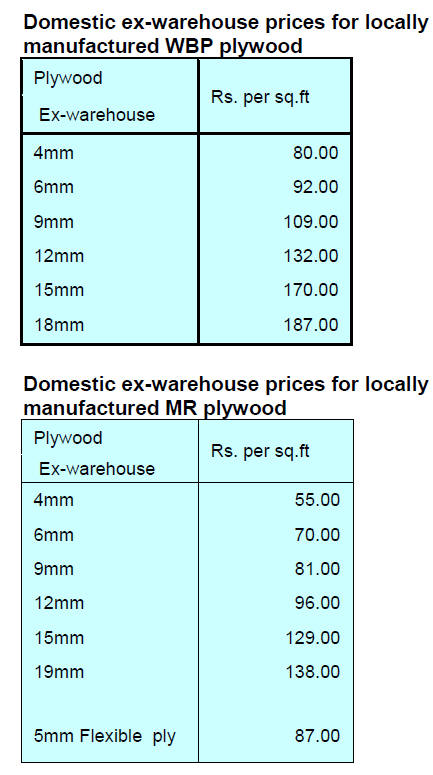
7.
VIETNAM
Wood and wood products (W&WP) trade
highlights
According to the General Department of Customs May 2023 W&WP
exports were worth an estimated at US$1.2 billion, up 10% compared to April
2023 but down 14% compared to May 2022.
WP exports were US$801 million, up 3% compared to April 2023 but down 16%
compared to May 2022. Over the first 5 months of 2023 W&WP exports totalled
at US$5.1 billion, down 27% over the same period in 2022. In particular
exports wood products at an estimated at US$3.4 billion were down 34% over
the same period in 2022.
Vietnam's imports of logs and sawnwood in May 2023 amounted to 500,900
cu.m, equivalent to US$180.3 million, up 51% in volume and 50% in value
compared to April 2023 but compared to May 2022, down 13% in volume and 22%
in value.
Over the first 5 months of 2023 imports of wood raw material were recorded
at 1.6 million cu.m, worth US$579.2 million, down 31% in volume and 35% in
value over the same period in 2022.
Vietnam's exports of NTFPs have been increasing for the first four months
in 2023 reaching US$70.0 million in May 2023, up 12% compared to April 2023
but down 0.3% compared to May 2022.
W&WP exports to the EU in May 2023 stood at US$33.6 million, down 39%
compared to May 2022. In the first 5 months of 2023 W&WP exports to the EU
were estimated at US$206.6 million, down 34% year-on-year.
W&WP exports to Australia in May 2023 were estimated at US$10.3 million,
down 37% compared to May 2022. In the first 5 months of 2023 exports of wood
and wood products to Australia were estimated at US$46 million, down 43%
year-on-year.
Exporters of wood products face many difficulties
Vietnam’s W&WP trade is not expected to increase unless the global
economy regains growth momentum and consumer demand in key markets recovers.
In spite of the cloudy situation, Vietnamese wood processors and traders
forecast better trends in late 2023 - early 2024 when inflation prevailing
in many economies will be controlled and the Russia-Ukraine conflict may
end.
Topping export turnover in the first 4 months of 2023 were wooden-frame
seats with an export value of US$831.5 million, down 32% over the same
period in 2022, followed by wood chips US$691.7 million, up 2%; living and
dining room furniture US$644.4 million, down 43%; wood-based and panels and
floorings, US$501.6 million, down 28%; bedroom furniture, US$478.8 million,
down 33%.

W&WP exports in April and the first 4 months
of 2023
Except for Japan W&WP exports to key markets experience a sharp
turndown in the first four months of 2023. The US market, as the leading
market, consumed over US$2.0 billion, down 40% year-on-year; Japan is the
second market with US$556 million, up 1.8%; China, US$481.2 million, down
11%; Korea, US$273.5 million, down 23%; EU, US$151.6 million, down 42%.
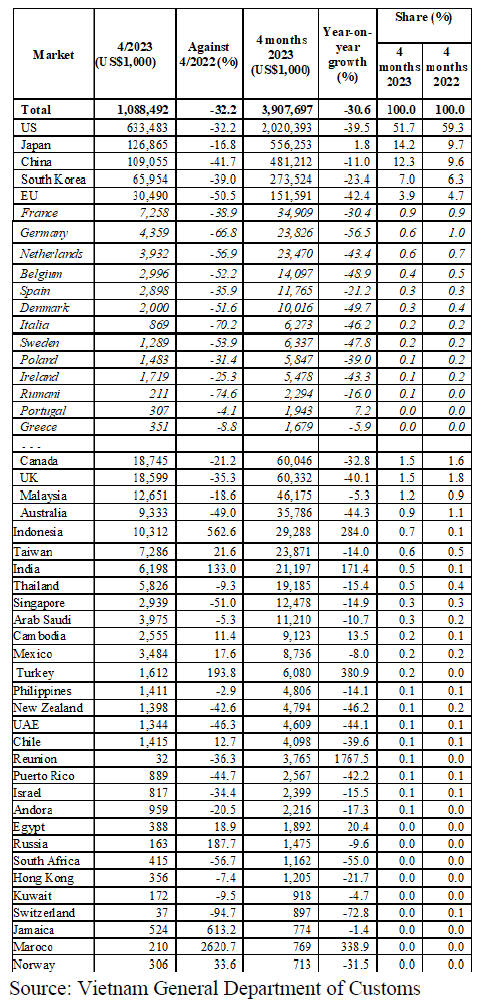
Vietnamese wood exports declined in first
five months
The export of wood and wooden products continued a downward in
early 2023 with export values hitting US$5.1 billion to mark a year-on-year
fall of 27%.
According to the Ministry of Industry and Trade, May alone witnessed the
nation’s export value of wood and wooden products stand at an estimated
US$1.2 billion, up by 10% against April but down by 14% against May 2022.
Most notably, May saw exports of wooden products reach US$801 million, up 3%
on-month but down by 16% on-year. Wooden furniture represented the key
export item accounting for 60% of total exports of wood and wood products.
Throughout the January to May period the export value of wooden furniture
fell sharply by 38% against the same period from last year due to slowing
global demand. High inflation across the world has forced consumers to
tighten their spending as they seek to decrease demand for non-essential
goods such as wood products.
Those factors have led to Vietnamese export value of wood and wooden
products plunging during the reviewed period.
See:
https://wtocenter.vn/tin-tuc/22083-vietnamese-wood-exports-decrease-over-five-month-period
Imports falling
In the first 5 months of 2023, the imports of logs and sawnwood
amounted to 1.6 million cu.m, worth US$579.2 million, down 31% in volume and
36% in value over the same period in 2022.
In the first 4 months of 2023 imports of raw wood from major markets, such
as the EU, Cambodia, China, the US, Thailand, Laos, Chile, New Zealand and
Brazil dropped down against the same period in 2022. At the same time, the
imports from some other markets, such as Malaysia, Angola, Indonesia, Canada
and Namibia increased.
The raw wood imports from the EU markets amounted to 15% of total imported
volume, contributing 190,600 cu.m, worth US$58.2 million, down 18% in volume
and 21% in value over the same period in 2022.
From Cameroon imports decreased year-on-year by 4% in volume and 2% in value
and were 169,300 cu.m, worth US$73.2 million, accounting for 13% of the
total imports.
Imports from the China fell by 33% in volume and 40% in value against the
same period in 2022, amounted to 157,600 cu.m, worth US$76 million, a 13%
share of total imports.
In addition, the import volume of raw wood from some other markets decreased
against the same period in 2022. In particula imports from the US dropped by
5%, Thailand by 25%, Laos by 17%, Chile by 29%, New Zealand by 25%, Brazil
by 59% and Congo by 17%.
In contrast, imports of raw wood from Malaysia increased by 68% in volume
and 24% in value over the same period in 2022, reaching 27,400 cu.m, worth
US$7.2 million, accounting for 2% of total imports.
In addition, imports of raw wood into Vietnam from some other markets in the
first 4 months of 2023 showed an increase compared to the same period in
2022: from Angola increased by 10%; Indonesia by 75%; Canada by 3%, Namibia
by 36%, Equatorial Guinea by 45% and Mozambique by 19%.
Vietnam’s log and sawnwood imports by source and species
In the first 4 months of 2023 imports of major species such as
pine, tali, poplar, oak, doussi/pachi, padouk and eucalyptus declined
year-on-year. Conversely, import volumes of some other species increased,
namely ash, rubberwood, mukulungu, walnut, lagerstromia, menghundor and
douglas fir.
Pine, as the top species imported, accounted for 11%
of total imported raw wood in the first 4 months of 2023, reaching 142,500
cu.m, worth US$31.7 million, down 51% in volume and 61% in value over the
same period in 2022.
Tali/okan imports decreased by 18% in volume and 173% in value over the same
period in 2022, reaching 141,900 cu.m, valued at US$58.6 million and
contributing 11% of total imports.
Poplar imports dropped by 16% in volume and 27% in value year-on-year,
accounting for 80,500 cu.m, valued at US$33.4 million.
In addition, imports volume of some other species decreased compared with
the same period in 2022, such as doussie by 40%, padouk by10%, eucalyptus by
72%, teak by 26% and sapele by 17%.
Conversely, imports of ash in the first 4 months of 2023 surged by 5% in
volume and 18% in value over the same period in 2022, reaching 127,200 cu.m,
worth US$32.8 million, accounting for 10% of total imported raw wood.

Forecast W&WP trade
In the first 5 months of 2023, Vietnam's W&WP exports plummeted by
27% over the same period in 2022 with an export value of US$5.1 billion. The
reason behind the serious downturn in W&WP exports is recession of the
global economy leading to the weakened market demand.
There are signs of recovery but the W&WP markets will barely recover.
Moreover, increasing concerns on the EUDR will trigger new technical and
environmental barriers to the W&WP trade. In addition, China's reopening has
also doubled the competition in Vietnam's W&WP export markets. Apparently,
in both the short term and long term, these factors will continue impacting
the Vietnamese wood industry sector.
Besides the decline of export orders the serious drop of export prices also
exposes another factor worsening the export turnover of W&WP made in
Vietnam. On the other hand, Vietnam, as a big importer, can hardly maintain
the normal level of wood imports with the weakened W&WP demands for both
domestic use and export.
8. BRAZIL
Law on carbon credit trading in public
forests
The law No. 14.590/23, published in the official gazette, changes
the rules of public forest management through concessions. The law allows
the trade in carbon credits and the exploitation of biodiversity in the
granted concession area which until now was prohibited.
According to the law, the public notice of the concession for the
utilisation of forests may include the right to commercialise carbon credits
and other similar instruments for the mitigation of greenhouse gas
emissions.
Non-timber forest products and services may also be the object of forest
concession management. The new law also allows the concessionaire of public
forests to unify forest management activities in contiguous areas of lands
in protected areas.
The new law also provides for:
The Brazilian Forestry Service (SFB) preparation of the Multi-Year Plan
for Forest Granting (PPAOF) with a duration of four years containing the set
of public forests to be granted in the period in which it is in force;
The absolute reserve area (area within the concession that cannot be
exploited) may be located around the conservation unit ( buffer zone ). In
this way, the entire concession area is free for the concessionaire's use in
accordance with the contract;
The granting authority may call the remaining bidders for the public
forest concession in order of classification when the concession contract is
terminated. The new concessionaire must accept the terms of the previous
contract;
The bidding notice for the public forest must provide for civil liability
insurance against any damage caused to the environment or to third parties,
in addition to a guarantee to cover the default of contractual obligations.
Source: Agência Câmara de Notícias
See:
https://www.camara.leg.br/noticias/965520-lei-autoriza-comercio-de-credito-de-carbono-e-acesso-a-biodiversidade-em-florestas-publicas/
Leaves from Amazon tree could replace mercury in gold recovery
Research conducted by the Brazilian Agricultural Research
Corporation (Embrapa) has shown that bio-extraction obtained through use of
the leaves of pau-de-balsa (Ochroma pyramidale), a tree native to the
Amazon, may be a viable and sustainable alternative to replace mercury in
gold recovery.
A new research stage will study which formulations
of bio-extractors can be competitive with mercury. The study will be
coordinated by Embrapa Forests, in Paraná State in partnership with other
research institutions.
The first phase of the research, carried out in 2020, focused on the
chemical characterisation of the pau-de-balsa leaves. In 2023 a new stage of
the study will begin which will be conducted in partnership with a mine in
the Peixoto de Azevedo Region, in Mato Grosso State.
Various bio-extraction formulations will be evaluated for their efficiency
in recovering gold from alluvial ore. The bio-extractor that performs best
will be adjusted to further improve extraction. The extraction efficiency
will be compared to the traditional process through amalgamation with
mercury. In addition, toxicity and cytotoxicity analyses will be carried
out.
The pau-de-balsa tree is fast growing and contributes to improve the
development of secondary forests and can be used in forest restorations. In
the case of the adoption of the pau-de-balsa leaves for gold recovery the
idea is that it will be associated with the use of the species for the
recovery of land affected by mining.
See:
https://www.nativanews.com.br/meio_ambiente/id-1048549/pesquisa_estuda_folha_da_amaz_nia_para_substitui__o_do_merc_rio_na_extra__o_de_ouro
Timber export control for Brazilian wood
According to a Brazilian Institute of the Environment and Renewable
Natural Resources (IBAMA) Timber Management Analytical Report the most
exported species for use in the design and architectural sectors are: ipê (Handroanthus),
cumaru (Dipteryx odorata), garapa (Apuleia leiocarpa) and jatobá (Hymenaea
courbaril).
According to IBAMA's 2022 report the European Union is the largest buyer of
Brazilian wood products taking around 143,000 cu.m worth about R$1 billion
followed by the United States with a purchase of almost 83,000cu.m also
worth about R$1 billion.
The Convention on International Trade in Endangered Species of Wild Fauna
and Flora (CITES) regulates the process of exporting and importing fauna and
flora. According to IBAMA some of the most exported plant species in Brazil
are already listed in CITES Appendix II. These are Dipteryx odorata and
Handroanthus serratifolius (yellow ipê). Others are in the MMA Ordinance No.
443/2014 (List of Brazilian flora species threatened with extinction), such
as Araucaria augustifolia, Apuleia leiocarpa and Mezilaurus itauba.
To ensure legality the first step is to know the origin of the wood.
Although it is difficult to know the true origin of the material, the
Brazilian Association of Interior Designers (ABD) advises checking the
Forest Stewardship Council (FSC) label, in addition to the Forest Origin
Document (DOF) of IBAMA.
According to IBAMA there are a series of norms that regulate the procedures
for authorising the export of wood products and by-products from native
timber species.
Among these are the Normative Instruction IBAMA No. 8/2022 and Normative
Instruction No. 17/2021 which aim to control the export of wood from natural
forests.
Normative Instruction No. 21/2014, established the National System for the
Control of the Origin of Forest Products (SINAFLOR) to control the origin of
wood, charcoal and other forest products and by-products. There is also
Decree No. 3.607/2000 which deals with the implementation of CITES. There is
also Ordinance No. 8/2022, which established the Brazil Single Consent
Platform (PAU Brazil) under IBAMA.
Finally, SECEX Ordinance No. 19/2019, which conrols export licenses, permits
and certificates (LPCO) through the Foreign Trade Single Portal of the
Integrated Foreign Trade System (Siscomex).
See:
https://revistacasaejardim.globo.com/um-so-planeta/noticia/2023/05/entenda-como-funciona-a-fiscalizacao-para-o-uso-de-madeira-brasileira.ghtml
Pará state teak exported to India
India is the main importer of teak roundwood (Tectona grandis)
produced from reforested areas. These forests help to recover degraded land,
create employment, generate foreign exchange and generate income for
municipalities and for the State of Pará.
The State of Pará is the main exporter of wood products from native timber
species and exports of wood products from reforestated areas have been
growing.
According to the Association of Timber Exporting Industries of the state of
Pará (AIMEX), in the first four months of the year timber exports from
reforestation represented the third most valuable product with more than
28,000 tonnes exported worth US$4.9 million with India as the main
destination.
Teak was introduced to Brazil in the 1960s and the first plantations began
in the Pará State in the 1990s.
Currently, Brazil has the largest planted area in Latin America with more
than 90,000 hectares of teak plantations spread over the States of Mato
Grosso, Pará, Rondônia, Acre, Goiás, Minas Gerais, among others. Mato Grosso
and Pará States account for more than 90% of the planted teak area in the
country.
See:
https://redepara.com.br/Noticia/234247/madeiras-plantadas-no-para-sao-utilizadas-na-india
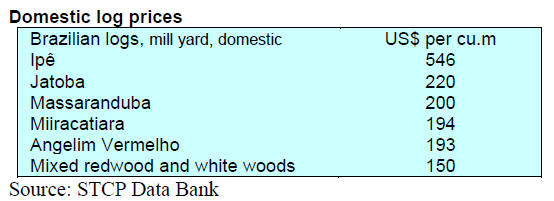
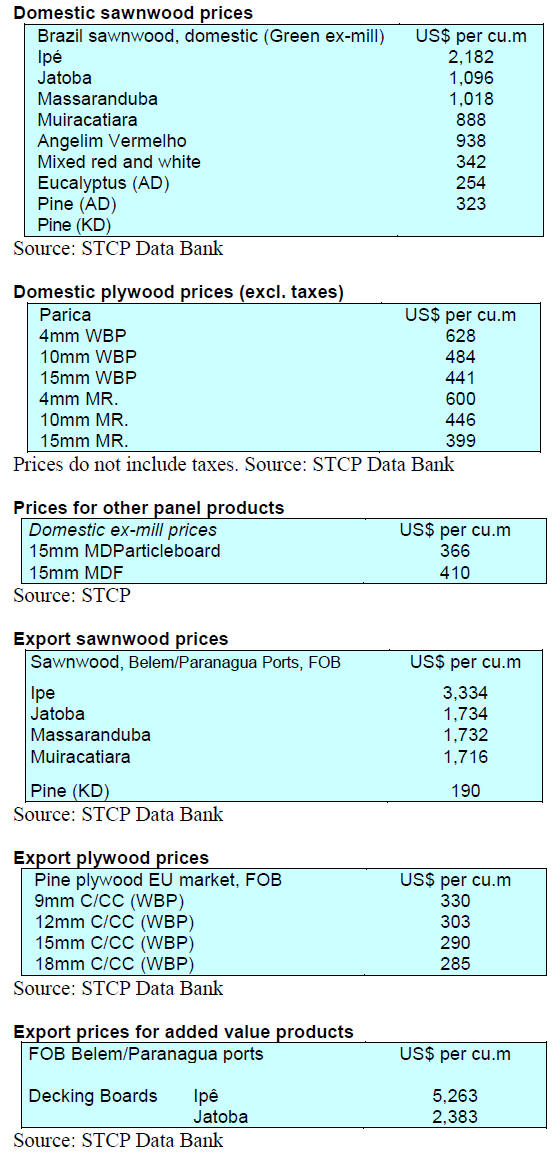
Through the eyes of industry
The latest GTI report lists the challenges identified by the
private sector in Brazil.
See:
https://www.itto-ggsc.org/static/upload/file/20230615/1686792092163403.pdf
9. PERU
ADEX requests change to forestry
legislation
According to the president of the Timber and Timber Industry
Committee of the Association of Exporters (ADEX), Erik Fischer Llanos, while
there is a regulatory framework that aims for best forest practices the
legislation, in effect, limits the competitiveness of the sector.
Fischer suggested it necessary to open a debate with the Legislative Branch
to modify the appropriate laws in support the forestry sector which
generated 27,337 jobs during 2022, being the third largest activity that
generated the most employment for every million dollars in exports.
One of the modifications would be Article 46 of the Forestry Law which
establishes the verification of 100% of the species included in CITES the
deadlines for which result in a considerable administrative and financial
burden.
Fischer considered necessary the promulgation of laws with a technical
basis, taking account of reality and taking into account social needs so as
to promote productivity in the sector.
In addition, Fischer indicated the Association was in favor of the Bill
whose purpose is to modify the Law for the Promotion of Investment in the
Amazon with the aim of specifying that the commercialisation of carbon
credits (bonds) generated in Emission Reduction projects derived from the
Deforestation and Forest Degradation (REDD+), ecosystem services, must be
included in the scope of Law No. 27037.
See:
https://agraria.pe/noticias/urge-adecuar-legislacion-para-impulsar-el-desarrollo-del-sec-31951
Indigenous people to manage their own forest resources
In the fight against illegal logging, deforestation and timber
trafficking in the Peruvian Amazon several indigenous communities in the
Ucayali region strengthened their technical capacity to improve sustainable
management of their forest resources.
Through the Intercultural Training Programme for Trainers in Community
Forest Management (PIFFMFC) leaders and members of the native communities
benefitted from training that will allow them to manage their own forest
resources.
This initiative was promoted by the National Forest and Wildlife Service
(SERFOR) and was supported by WWF Peru, the Ucayali Wildlife Forest
Management (GERFFS-U), the Aidesep Ucayali Regional Organisation (ORAU) and
the Union Region of the Indigenous Peoples of the Amazon (URPIA). The
results of this training will be assessed with the expectation that the
leaders will implement what they have learned and put the necessary systems
into practice.
OSINFOR promotes good practices to improve forest management
Timber concessionaires and holders of forest permits on private
land in the Loreto Region strengthened their capacity to carry out
sustainable management in their forest areas during a workshop held in
Iquitos, Loreto.
A group of OSINFOR trainers explained to 29
attendees including holders of qualifying titles, regents and
representatives of timber concessions and forestry permits what are the
commitments they accept when the State grants them qualifying titles and
obligations they must comply with to avoid falling into forest violations.
During the workshop the relevance of meeting the necessary commitments to
obtain a certificate of compliance was discussed. The imposition of
penalties for forestry and wildlife violations was also explained.
Model to combat corruption in the forestry sector
On May 25, 2023the National Forestry and Wildlife Service (SERFOR),
Ministry of Agrarian Development and Irrigation (MIDAGRI), signed an Act of
Commitment for the Implementation of an Integrity Model through a General
Management Resolution which approved the SERFOR 2023 Integrity Programme.
This action is part of SERFOR's commitment to promote the integrity of its
officials and fight corruption. Advances have been made in the Integrity
Model by approving the pertinent instruments to generate greater confidence.
Through this it has been possible to address the negative perceptions
detailed in the 2022 Integrity Report prepared by the Secretary of Public
Integrity of the Presidency of the Council of Ministers.
SERFOR committed to the fight against corruption by creating the Functional
Integrity Unit (UFI) that reports to the General Management and is in charge
of providing guidance and technical assistance to all the management units.
See:
https://www.gob.pe/institucion/serfor/campa%C3%B1as/9443-implementacion-del-modelo-de-integridad-en-el-serfor
